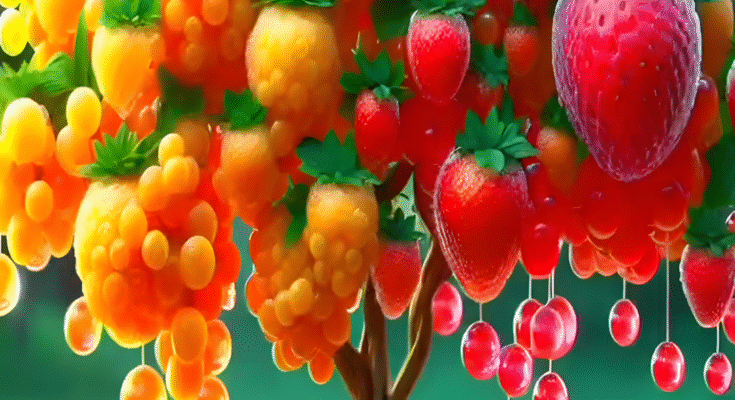Quick and Easy Method for Growing and Planting Hybrid Fruit Trees of Orange and Strawberry
Hybrid fruit trees are gaining popularity among gardeners and fruit lovers who want to enjoy the best of two different fruits on one tree. One fascinating hybrid concept that has captured attention is the combination of oranges and strawberries. Though they are from different plant families, with the right techniques, you can successfully grow them side by side or use creative grafting and companion planting methods to simulate a hybrid fruit system. In this article, we will explore a quick and easy method for growing and planting a hybrid fruit tree that mimics both orange and strawberry characteristics in one setup.
Step 1: Understanding the Hybrid Concept
True genetic hybrids between oranges (a citrus tree) and strawberries (a herbaceous plant) are not naturally possible because they belong to entirely different plant families. However, through advanced horticultural techniques like dual-root pot grafting, companion planting, and vertical gardening systems, you can grow both fruits in harmony, giving the impression of a single “hybrid” plant.
This method involves growing an orange tree in a container or small space and integrating strawberries around its base or in a multi-layer planter system. The result is an eye-catching and highly productive arrangement.
Step 2: Choosing the Right Varieties
Select compact or dwarf varieties of orange trees and ever-bearing strawberries that thrive in similar growing conditions.
- Best Orange Varieties: Calamondin, Dwarf Valencia, or Washington Navel are ideal due to their manageable size and productivity.
- Best Strawberry Varieties: Albion, Seascape, or Tristar—these are day-neutral types that bear fruit continuously with proper care.
These choices allow both fruits to be grown together in containers or raised beds efficiently.
Step 3: Preparing the Planting Area or Container
This hybrid method works great in containers or raised garden beds.
For Containers:
- Choose a large pot (minimum 24 inches wide and deep).
- Ensure good drainage holes at the bottom.
- Use high-quality potting mix rich in organic matter, well-draining, and slightly acidic (pH around 6.0–6.5).
- Fill two-thirds of the pot with soil and place the orange sapling in the center.
For Raised Beds:
- Prepare a raised bed 3×3 feet or larger.
- Mix compost, garden soil, and sand for better aeration and nutrition.
- Plant the orange tree at the center, with enough space for strawberry runners around it.
Step 4: Planting the Strawberry Plants
Once the orange tree is planted, plant the strawberry runners around the base of the tree.
- Keep a distance of about 6–8 inches between each strawberry plant.
- Ensure their crowns (the thick part between the root and leaves) are above soil level.
- Lightly mulch with straw, dry leaves, or coconut husk to retain moisture and suppress weeds.
This layering allows strawberries to spread around the orange tree like a living mulch while saving space.
Step 5: Watering and Fertilizing
Both oranges and strawberries love moist, well-drained soil but dislike waterlogged roots.
- Watering: Water regularly but avoid soggy conditions. Drip irrigation or a watering can with a long spout is ideal.
- Fertilizer: Use a balanced organic fertilizer once a month.
- For oranges, use a citrus-specific fertilizer rich in nitrogen and magnesium.
- For strawberries, a general-purpose fruit fertilizer with potassium helps fruiting.
Avoid over-fertilization, especially with nitrogen, as it can reduce fruit production.
Step 6: Using Natural Growth Stimulants
You can use homemade or organic stimulants to speed up growth and fruit production.
- Banana Peel Tea: Rich in potassium and phosphorus. Soak banana peels in water for 2–3 days, then use the liquid to water your plants.
- Eggshell Water: Crush eggshells and soak them in water overnight. Use this calcium-rich solution once a week.
- Aloe Vera Juice: Acts as a natural rooting hormone. Mix with water and spray on the plant base monthly.
These simple boosters can support both strawberries and oranges, making your hybrid system thrive.
Step 7: Maintenance and Pruning
- Orange Tree: Prune once or twice a year to maintain shape and airflow. Remove dead or crossing branches.
- Strawberries: Remove old or diseased leaves. Allow only a few runners to grow; cut the rest to conserve energy.
Also, hand-pollination using a small brush may help improve yields, especially for container plants with limited bee access.
Step 8: Pest and Disease Management
- Keep an eye out for aphids, whiteflies, and spider mites.
- Use neem oil or insecticidal soap weekly as a preventive measure.
- Avoid overwatering to prevent root rot and fungal diseases.
- Rotate mulch and clean old leaves to prevent harboring pests.
Healthy plants resist pests better, especially when supported by natural fertilizers and proper spacing.
Step 9: Harvesting
- Oranges: Typically mature in 6–12 months depending on variety and care. Harvest when color deepens and fruit is slightly soft.
- Strawberries: Ready to pick 4–6 weeks after flowering. Harvest when fully red and plump.
The visual beauty of red strawberries hanging under a lush orange tree canopy creates a stunning garden display and fruitful reward.
Final Thoughts
Growing a hybrid-style fruit tree that combines oranges and strawberries may sound unusual, but with creative gardening techniques, it’s easy and very rewarding. By using a dwarf orange tree as the vertical centerpiece and strawberry plants as ground covers or hanging layers, you create a visually attractive and highly productive system. This method saves space, encourages biodiversity, and brings the joy of harvesting two fruits from one planting area.
With just a bit of planning and ongoing care, your garden can become a tropical fruit paradise—quickly and easily.



